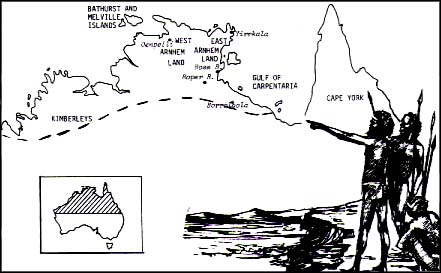What Is a Didgeridoo?
"As with imagemaking, Aboriginal music also unites consciousness with the invisible laws and energy patterns of nature. Aboriginal art is perhaps most accurately described as a method for gaining knowledge of nature and its invisible Dreaming. An example is the playing of the didjeridoo, a long wooden flute, perhaps the oldest musical instrument on earth.
Traditionally, an Aborigine would go into nature and listen intensely to animal sounds, not just voices but also the flapping of wings or the thump of feet on the ground. The Aborigine would also listen to the sounds of wind, thunder, trees creaking, and water running. The essences of all these sounds were played with as much accuracy as possible within the droning sound of the didjereedoo. For the Aborigine, the observation of nature immediately requires a state of empathy, which leads to am imitative expression."
Reference: Voices of the First Day, Published by Inner Traditional
10 Didgeridoo Facts
- Possibly the world's oldest musical instrument.
- A wind instrument originally found in Arnhem Land, Northern Australia.
- Is made from limbs and tree trunks hollowed out by termites (insects).
- Is cut to an average length of 1.3 metres and cleaned out with a stick. or hot coals.
- Was used as an accompaniment to chants and songs.
- Produces a low-pitch, resonant sound with complex rhythmic patterns.
- In sure tribal groups only played by men but in most groups by men, women and children.
- Traditional forms of the didjeridoo where found right accross the Australian Northern Territory.
- The Didgeridoo is the sound of Australia.
- If the earth had a voice it would be the sound of the Didgeridoo.
History of the Word Didgeridoo
Didgeridoo - Also didjeridu, didjiridu and didjerry.
1919 Huon Times (Franklin) 24 January 4/3
The ****** crew is making merry with the Diridgery doo and the eternal
ya-ya-ya- ye-ye-ye cry.
1919 Smith's Weekly (Sydney) 5 April 15/1
The Northern Territory Aborigines have an infernal and allegedly
musical instrument, composed of two feet of hollow bamboo. It produces
but one sound - 'didjerry, didjerry, didjerry' and so on ad infinitum.
1925 M.TERRY Across Unknown Australia 190
The didjiri-du.. is a long hollow tube, often a tree root about 5 feet long, slightly curved at the lower end. The musician squats on the ground, resting his instrument on the earth. He fits his mouth into the straight or upper end and blows down it in a curious fashion. He produces an intermittent drone.

Aboriginal Names
Aboriginal names for the instruments as there are identifiable language
groups. Some of its names, more especially those which suggest routes
and directions of the spread of this aerophone within Australia,
are given below.
In T.B. Wilson's Narrative of a Voyage Round the World (1835) there
is a drawing of an Aboriginal man of Raffles Bay, Coburg Peninsula,
playing the instrument. Several different observers at Raffles Bay
described it as being of bamboo and about three feet long. Names
obtained (obviously different spellings of the same Aboriginal word)
were eboro, ebero and ebroo.
Where Does the Word Didgeridoo Come From?
The fact that bamboo didjeridus were quite common among northerly groups in the Northern Territory during the last century is confirmed by the word 'bamboo' which is still used in the lingua franca by some Aborigines when referring to the instrument, though 'didjeridu' may be gaining ground.
The suggestion here is that the first didjeridus were of bamboo; and that because of the availability of bamboo in the north-western region of the Northern Territory, the first didjeridu players may well have belonged to that region. Some observations on 'three very curious trumpets' made by R.Etheridge Jr. in 1893 are quoted for consideration in this context as they refer particularly to instruments of bamboo. Etheridge writes that '[the trumpets] are made from bamboo lengths, the diaphragms having been removed, probably by dropping live coals down the tubes.

The bamboo, I am informed by Mr Stockdale, grows about the Adelaide River over an area of about one hundred miles by fifty, and reaches to a height of eighty feet, Mr J.H. Maiden tells me there are two bamboos indigenous in Australia, Bambusa arnhemica and B.moreheadiana, the latter a climbing species and only one or two inches in diameter.
What Are Other Didgeridoo Names?
According to Prof Trevor Jones, (Monash University) there are at least 45 different synonyms for the didgeridoo. Some are bambu, bombo, kambu, pampuu, (may reflect didge origins from bamboo), garnbak, illpirra, martba, Jiragi, Yiraki, Yidaki, (seem close dialectically and which means "bamoo" although no longer commonly made from bamboo).
TRIBAL GROUP REGION NAME FOR DIDGERIDOO
| TRIBAL GROUP | REGION | NAME FOR DIDGERIDOO |
| Anindilyakwa | Groote Eylandt | ngarrriralkpwina = play didge |
| Gupapuygu | Arnhem Land | Yiraka = trachea, windpipe |
| Djinang | Arnhem Land | Yirtakki |
| Iwaidja | Cobourg Peninsula | Wuyimba = trachea buyigi = blow a didgeridoo |
| Jawoyn | Katherine | artawirr = hollow log |
| Gagudju | Kakadu | garnbak |
| Lardil | Mornington Island | djibolu |
| Ngarluma | Roebourne, WA | Kurmur |
| Nyul Nyul | Kimberleys WA | ngaribi = bamboo |
| Warray | Adelaide River | bambu = used for singing |
| Mayali | Alligator River | martba |
